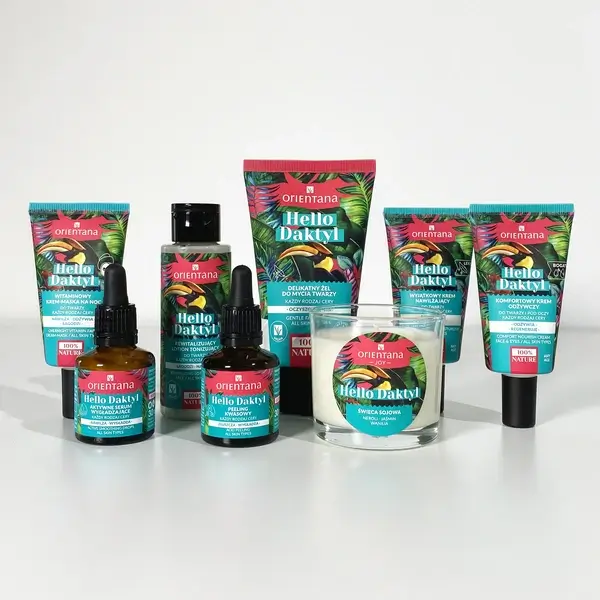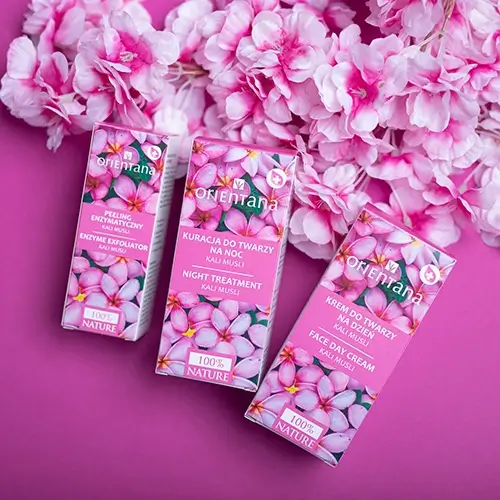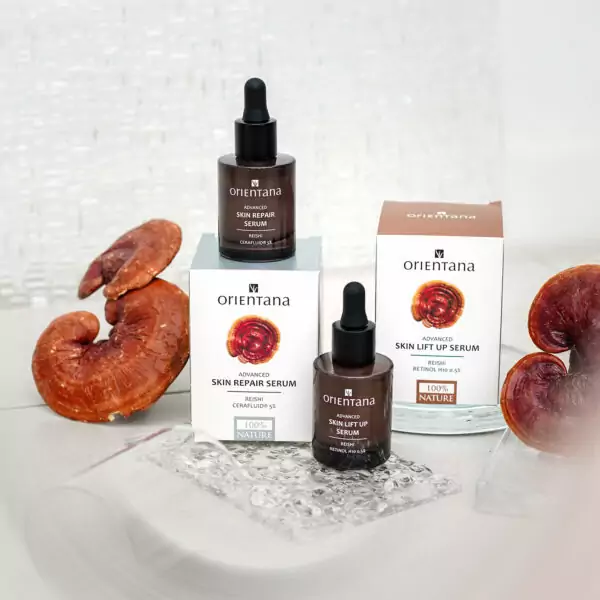Each of us can answer the question what kind of skin I have. But are we sure? How are individual skin types defined and how to check which one you have – you will learn this from the article below.
What are the skin types?
Basic skin types are divided into four main categories, plus additional types related to specific skin problems or the aging process.

what skin do I have? learn the basic types
Normal skin
It is characterized by even hydration, elasticity and no visible imperfections. Pores are small and the skin responds well to most cosmetics.
Dry skin
Thin, prone to drying, with a feeling of tightness and flaking. Requires intensive moisturization and protection from external factors.
Oily skin
Excessive sebum production causes shine, enlarged pores and a tendency to breakouts. It requires seborrhea regulation.
Combination skin
Combination of dry skin (e.g. cheeks) and oily skin (T-zone: forehead, nose, chin). Requires different care.
Additional skin types
Sensitive skin – reacts with redness, itching or burning to cosmetics or environmental factors.
Capillary skin – visible dilated blood vessels, prone to irritation.
Acne skin – dominated by pimples, blackheads and excessive sebum production, often requires dermatological consultation.
Mature skin – manifests itself through wrinkles, loss of firmness and irregular facial contours associated with age.
In practice, skin type may combine the features of the basic type with additional problems (e.g. oily skin with vascular elements). The key is to adapt care to the individual needs of the skin, but do I already know what type of skin I have?
No skin type is a given. It is often genetically determined, but it can change with age. Skin type also depends on how you care for it, your diet, hormone levels, and lifestyle.
What is my complexion? Tests
To determine your skin type, you can use online tests or analyze your symptoms yourself. Here are the key methods:
Tests with a dermatologist
A dermatologist asks a series of questions and observes the client's skin to select the right care. How does a dermatologist recognize your skin type? During the consultation, she asks a few simple questions that help assess the condition and type of your skin. The key is how your skin reacts to everyday factors - such as cleansing, weather changes or natural physiological processes. On this basis, you can accurately select the right care.
The first signal that a dermoconsultant pays attention to is the skin's reaction after washing. If you feel a strong feeling of tightness, dryness or burning after cleansing, this may indicate dry or sensitive skin that requires gentle, moisturising formulas and protection from external factors. On the other hand, if your complexion quickly starts to shine and you do not feel any discomfort, you probably have oily or combination skin - the kind that produces excess sebum and needs to regulate sebum secretion.
The next step is to observe the visibility of pores and the tendency to blemishes. If you notice enlarged pores, especially in the T-zone (i.e. on the forehead, nose and chin), and breakouts appear regularly - this may indicate oily or acne skin. It is also worth paying attention to whether skin changes intensify cyclically, for example before menstruation - this may indicate hormonal acne. On the other hand, skin without visible pores, with a smooth structure and no tendency to breakouts, often turns out to be dry or normal skin.
The skin's behavior in different weather conditions is also assessed. If your skin reacts with irritation, redness or burning to frost, wind or sudden changes in temperature, you most likely have sensitive or vascular skin. Such skin needs soothing cosmetics that strengthen the protective barrier and seal blood vessels. On the other hand, if your skin shines intensely in a humid environment, this indicates overactive sebaceous glands, i.e. oily or combination skin.
Thanks to these simple questions and observations, the dermatologist is able to determine not only the basic skin type – dry, oily, combination or normal – but also its needs and tendencies, such as sensitivity, tendency to dehydration, acne or overactive blood vessels. This is the first step towards conscious and effective care and finding out what kind of skin I have.
what skin type do I have - Self-analysis
Determining your skin type yourself is a key step in proper skin care. Observing your skin's reaction to various factors, such as washing or using cosmetics, allows you to precisely select the right care products.
Observation of the skin after washing
One of the easiest ways to analyze your skin is to observe how it reacts after washing your face with a gentle cleanser, without using creams or toners. After about 30 minutes, you can assess how your skin reacts to cleansing:
- Dry skin – after washing, there is a feeling of tightness, tension and discomfort. The skin is often dull, rough and may flake. The lack of natural moisture makes it look tired and prone to irritation.
- Oily skin – quickly begins to shine, especially in the T-zone (forehead, nose, chin). Pores are clearly visible, and the skin may appear to have a thicker, more oily film on the surface. It is often accompanied by blackheads and a tendency to imperfections.
- Combination skin – is characterized by different areas with different properties. The T-zone quickly becomes oily, while the cheeks can be dry and tight. Requires balanced care, adapted to different parts of the face.
- Normal skin – shows no signs of discomfort. The skin is smooth, elastic and naturally moisturized. The lack of dryness and excessive shine makes it look healthy and radiant.
Skin reaction to cosmetics
The next step in skin analysis is to observe the skin's reaction to various cosmetics, especially those containing active ingredients. Some skin types may require more gentle care, while others will tolerate stronger ingredients.

- Sensitive/vascular skin – reacts with redness, burning, and even itching to aggressive substances such as alcohol, retinoids, and some preservatives. It may have a tendency to burst blood vessels, which manifests itself as visible "spider veins" on the cheeks and nose. Requires the use of mild, hypoallergenic cosmetics. The Kali Musli series will be perfect here.
- Acne skin – is prone to frequent breakouts, blackheads and inflammation. It can be oily, but also dry due to the use of aggressive anti-acne products. It requires careful care, regulating sebum secretion and supporting skin regeneration.
What is my complexion? Test with blotting paper
At home, you can perform a simple test that will allow you to find out what type of skin you have. All you need are facial cleansing products and a thin tissue or tissue paper divided into layers. Here are five steps that will help you define your facial skin type:
- Thoroughly cleanse your face of any makeup residue and wash it with a gentle cosmetic. We recommend a makeup remover oil and a face wash foam.
- Gently dry your face with a clean towel, without rubbing.
- Do not apply any cosmetics to your face and wait 30 minutes. During this time, do not do any strenuous exercise or go outside. Let your skin breathe ?
- After 30 minutes, gently place a tissue or one layer of tissue on your face. Lightly pat the tissue onto your skin and wait a minute.
- Remove the tissue paper and hold it up to the light. You will see where the most sebum has been produced on your face.
If there are no traces of sebum on the tissue paper, you have dry or normal skin. When the traces of sebum form a visible letter T, your skin is combination. If the tissue paper is covered with sebum in many places or over the entire surface, you have oily skin. Pay attention to seasonal changes, because combination skin can become dry in the winter or oily in the summer.
Regular observation of the skin allows for a better understanding of its needs and the selection of appropriate cosmetics, which translates into a healthy appearance and everyday comfort.
What skin type do I have - additional tips
Mature skin is a type of skin that usually appears after the age of 35, although its features may appear earlier, depending on lifestyle, exposure to UV radiation, oxidative stress or hormonal balance. Characteristic symptoms are wrinkles , both facial and deeper, which first appear around the eyes, mouth and forehead. The skin loses firmness, elasticity and density, which can lead to facial contour disorders. This is often accompanied by a loss of radiance , dryness, roughness and uneven color.
Capillary skin, on the other hand, is manifested by the presence of dilated blood vessels , most often in the cheeks, nose and chin. The skin is sensitive, prone to redness, which may appear under the influence of changes in temperature, emotions, spicy foods or the use of inappropriate cosmetics. In the advanced stage, there may be persistent redness and a tendency to form telangiectasia (so-called spider veins). Capillary skin requires delicate care, strengthening the walls of blood vessels and protecting against irritants.
If the results are ambiguous, it is worth consulting a dermatologist or cosmetologist. You should always also take into account the age of the person whose skin type you are diagnosing. Oily skin will behave differently in a teenager than in a mature woman.
Natural cosmetics for different skin types
Natural cosmetics, based on plant extracts, oils and ingredients of mineral origin, are increasingly popular due to their mildness, high skin tolerance and multi-directional action. Properly selected natural ingredients can effectively support the needs of every type of skin, improving its condition, balance and appearance.
For dry skin, strongly moisturizing and lubricating ingredients work best, which help rebuild the skin's hydrolipid barrier. Among them, it is worth mentioning shea butter (Butyrospermum Parkii Butter) , avocado oil , argan oil and almond oil - rich in unsaturated fatty acids, vitamins A and E, perfectly soften the skin and protect it from moisture loss. Hyaluronic acid of plant origin and aloe additionally intensify hydration and soothe the feeling of tightness.
Oily and acne-prone skin requires ingredients that regulate sebum secretion, have anti-inflammatory and antibacterial properties. Tea tree oil, niacinamide (vitamin B3) and green tea extract work great here. These substances help cleanse pores, reduce imperfections and soothe inflammation without damaging the skin's natural protective barrier.
Sensitive and vascular skin requires soothing ingredients that strengthen blood vessels and reduce redness. In this group, the most commonly used are kali musli extract, as well as wild rose oil and panthenol . These are ingredients with soothing, anti-inflammatory and microcirculation-supporting effects that improve skin comfort and reduce hyperreactivity.
For mature skin, ingredients with regenerating, firming and antioxidant effects will be ideal. Pomegranate oil , snail slime , coenzyme Q10 , vitamin C and extracts from adaptogens such as Reishi or Rhodiola rosea help smooth wrinkles, improve skin elasticity and protect it from free radicals.
Natural care allows you to safely and effectively take care of the needs of different skin types. The key to success is the conscious selection of active ingredients that address specific skin problems while supporting its natural defense and regeneration functions.

Once you have determined what type of skin you have, it is worth focusing on the selection of cosmetics. Remember about cosmetics for cleansing and toning the skin. We know from experience that these steps are often omitted. Choose the right serum and cream. Enjoy conscious care.






